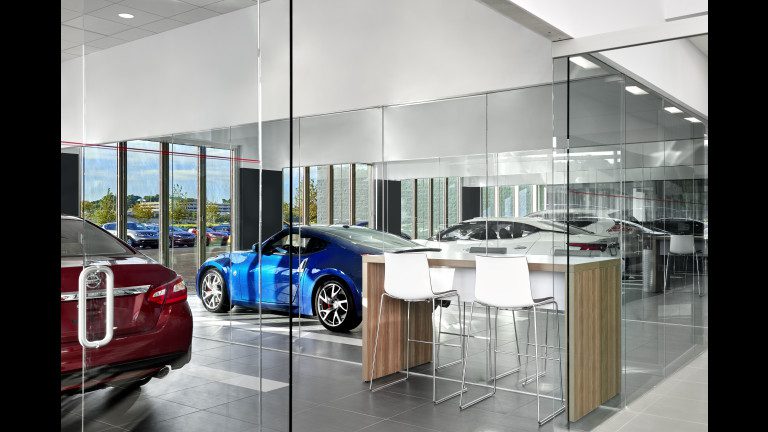

The familiar circular logo is staying, but Nissan Motor Company said that many showroom changes are afoot with the company aiming for upgrades in 9,000 of its 10,000 stores over the next five years.
The company says it is acknowledging the shifting customer expectations in today’s marketplace.
Look for the familiar cherry-red background and the circular, chrome logo on dealerships’ primary signage. While the exterior may look mostly unchanged – including platform display pads for featured cars on the lot – most of the changes Nissan is pushing in what they call the Nissan Retail Environment Design Initiative (or NREDI 2.0) are inside the stores and, critically, inside the cars, as well.
Nissan North America said that it was keeping cost estimates for the design changes close to the vest for proprietary reasons and that dealerships would “ultimately make their own decisions on implementation” of the new standards. They are, therefore, not mandatory, although reports indicate the company will be pressing forward on the changes in any dealership that is already planning extensive renovations or any brand new stores.
The reason for the change, said headquarters, is simple: “To improve customer services within a globally consistent brand experience in response to diversifying expectations and lifestyles.”
Many customers, in so many words, are going high-tech and expect stores to do the same. But some of them are still walking into stores with their hands in their pockets, as opposed to holding a smart phone. Hence, the need to accommodate “diverse expectations and lifestyles.”
NREDI 2.0, indeed, has design elements that embrace the digital revolution, while other aspects enhance a more organic experience, such as a waiting lounge for the service area that includes a glass wall, so customers can watch technicians work on their cars.
The changes have elements that resemble a sleek, modern resource library with an array of conveniently placed digital notepads in a shared sales and service lounge for quick electronic assistance when needed. There is a complimentary kids area, also equipped with digital notepads. There are glass-walled consultation rooms for the sales staff and an open consultation area for discussions with service technicians.
Featuring a large, flat-screened monitor, the makeovers will include a “Nissan Personalization Studio,” which allows for an interactive experience on a grand scale, allowing potential buyers to dream big while they play out purchase options on a big screen.
Nissan said more than 400 dealerships in 30 countries have already made the change, with the target set at 9,000 dealerships in more than 170 countries by the end of fiscal year 2022.
While the stores aim for a modern, almost World’s Fair atmosphere, an email response to questions from CBT News noted the changes are not just superficial. “Also incorporated are the Nissan brand’s key elements, such as Nissan Intelligent Mobility, electric vehicles, light commercial vehicles and the NISMO performance sub-brand.”
In fact, the company’s explanatory video concerning the NREDI 2.0 initiative starts with the premise that the cars are going high tech, so it’s about time the dealerships did the same. If that seems like a fairly basic, offhand observation, think again. It appears Nissan is being very sincere.







